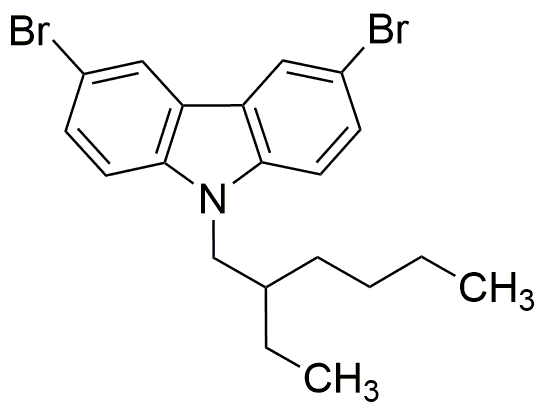3,6-Dibromo-9-(2-ethylhexyl)carbazole is widely utilized in research focused on:
- Organic Electronics: This compound is used in the development of organic light-emitting diodes (OLEDs), offering improved efficiency and color purity compared to traditional materials.
- Photovoltaic Cells: It serves as a key component in organic solar cells, enhancing light absorption and energy conversion efficiency, making solar technology more accessible and effective.
- Fluorescent Dyes: The compound is employed in creating fluorescent markers for biological imaging, providing high sensitivity and specificity for researchers in the life sciences.
- Polymer Additives: It acts as a flame retardant in polymers, increasing safety in materials used in construction and consumer products, thus addressing fire hazard concerns.
- Environmental Monitoring: This chemical is utilized in sensors for detecting pollutants, aiding industries in compliance with environmental regulations and promoting sustainability.
General Information
Properties
Safety and Regulations
Applications
3,6-Dibromo-9-(2-ethylhexyl)carbazole is widely utilized in research focused on:
- Organic Electronics: This compound is used in the development of organic light-emitting diodes (OLEDs), offering improved efficiency and color purity compared to traditional materials.
- Photovoltaic Cells: It serves as a key component in organic solar cells, enhancing light absorption and energy conversion efficiency, making solar technology more accessible and effective.
- Fluorescent Dyes: The compound is employed in creating fluorescent markers for biological imaging, providing high sensitivity and specificity for researchers in the life sciences.
- Polymer Additives: It acts as a flame retardant in polymers, increasing safety in materials used in construction and consumer products, thus addressing fire hazard concerns.
- Environmental Monitoring: This chemical is utilized in sensors for detecting pollutants, aiding industries in compliance with environmental regulations and promoting sustainability.
Documents
Safety Data Sheets (SDS)
The SDS provides comprehensive safety information on handling, storage, and disposal of the product.
Product Specification (PS)
The PS provides a comprehensive breakdown of the product’s properties, including chemical composition, physical state, purity, and storage requirements. It also details acceptable quality ranges and the product's intended applications.
Certificates of Analysis (COA)
Search for Certificates of Analysis (COA) by entering the products Lot Number. Lot and Batch Numbers can be found on a product’s label following the words ‘Lot’ or ‘Batch’.
Numéro de catalogue
Numéro de lot/série
Certificates Of Origin (COO)
This COO confirms the country where the product was manufactured, and also details the materials and components used in it and whether it is derived from natural, synthetic, or other specific sources. This certificate may be required for customs, trade, and regulatory compliance.
Numéro de catalogue
Numéro de lot/série
Safety Data Sheets (SDS)
The SDS provides comprehensive safety information on handling, storage, and disposal of the product.
DownloadProduct Specification (PS)
The PS provides a comprehensive breakdown of the product’s properties, including chemical composition, physical state, purity, and storage requirements. It also details acceptable quality ranges and the product's intended applications.
DownloadCertificates of Analysis (COA)
Search for Certificates of Analysis (COA) by entering the products Lot Number. Lot and Batch Numbers can be found on a product’s label following the words ‘Lot’ or ‘Batch’.
Numéro de catalogue
Numéro de lot/série
Certificates Of Origin (COO)
This COO confirms the country where the product was manufactured, and also details the materials and components used in it and whether it is derived from natural, synthetic, or other specific sources. This certificate may be required for customs, trade, and regulatory compliance.


